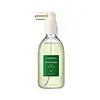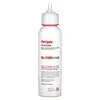What's inside
What's inside
 Key Ingredients
Key Ingredients

 Benefits
Benefits

 Concerns
Concerns

 Ingredients Side-by-side
Ingredients Side-by-side

Alcohol Denat.
AntimicrobialRosmarinus Officinalis Leaf Extract
AntimicrobialPinus Densiflora Leaf Extract
AntimicrobialWater
Skin ConditioningRosmarinus Officinalis Leaf Oil
MaskingZingiber Officinale Root Extract
MaskingBifida Ferment Lysate
Skin ConditioningLactobacillus Ferment Lysate
Skin ConditioningCaffeine
Skin ConditioningPanthenol
Skin ConditioningBiotin
AntiseborrhoeicThiamine Hcl
MaskingPyridoxine Hcl
Skin ConditioningAscorbic Acid
AntioxidantMenadione
MaskingRiboflavin
Cosmetic ColorantOryza Sativa Extract
AbsorbentGlycine Soja Seed Extract
Skin ConditioningSesamum Indicum Seed Extract
Skin ConditioningSolanum Melongena Fruit Extract
Skin ConditioningMorus Alba Fruit Extract
AntioxidantPiper Nigrum Seed Extract
RefreshingSalicylic Acid
MaskingLavandula Angustifolia Oil
MaskingMenthol
MaskingGlycerin
HumectantEthylhexylglycerin
Skin ConditioningCitrus Aurantium Dulcis Peel Oil
MaskingMentha Viridis Leaf Oil
AstringentMelia Azadirachta Leaf Extract
Skin ConditioningMelia Azadirachta Flower Extract
Skin ConditioningGeraniol
PerfumingLimonene
PerfumingLinalool
Perfuming1,2-Hexanediol
Skin ConditioningBenzyl Glycol
SolventAlcohol Denat., Rosmarinus Officinalis Leaf Extract, Pinus Densiflora Leaf Extract, Water, Rosmarinus Officinalis Leaf Oil, Zingiber Officinale Root Extract, Bifida Ferment Lysate, Lactobacillus Ferment Lysate, Caffeine, Panthenol, Biotin, Thiamine Hcl, Pyridoxine Hcl, Ascorbic Acid, Menadione, Riboflavin, Oryza Sativa Extract, Glycine Soja Seed Extract, Sesamum Indicum Seed Extract, Solanum Melongena Fruit Extract, Morus Alba Fruit Extract, Piper Nigrum Seed Extract, Salicylic Acid, Lavandula Angustifolia Oil, Menthol, Glycerin, Ethylhexylglycerin, Citrus Aurantium Dulcis Peel Oil, Mentha Viridis Leaf Oil, Melia Azadirachta Leaf Extract, Melia Azadirachta Flower Extract, Geraniol, Limonene, Linalool, 1,2-Hexanediol, Benzyl Glycol
Water
Skin ConditioningOnsen-Sui
Dipropylene Glycol
HumectantCaprylic/Capric Triglyceride
MaskingCetearyl Alcohol
EmollientCetyl Alcohol
EmollientStearyl Alcohol
EmollientBrassicamidopropyl Dimethylamine
Skin ConditioningBehentrimonium Chloride
PreservativeBehentrimonium Methosulfate
Parfum
MaskingBehenyl Alcohol
EmollientGlyceryl Stearate
EmollientSteartrimonium Chloride
PreservativeQuaternium-33
Alcohol
AntimicrobialPentylene Glycol
Skin ConditioningPropylene Glycol
HumectantIsopropyl Myristate
EmollientPanthenol
Skin ConditioningPropanediol
SolventZinc Pyrithione
AntiseborrhoeicCitric Acid
BufferingButylene Glycol
HumectantSalicylic Acid
MaskingMenthol
MaskingPolyquaternium-10
Guar Hydroxypropyltrimonium Chloride
Skin ConditioningCaprylyl Glycol
EmollientLanolin Acid
CleansingEthylhexylglycerin
Skin ConditioningDisodium EDTA
Laurdimonium Hydroxypropyl Hydrolyzed Wheat Protein
Cnidium Officinale Rhizome Extract
Skin ConditioningPanax Ginseng Root Extract
EmollientSodium Citrate
BufferingHydrolyzed Soy Protein
HumectantHydrolyzed Keratin
HumectantZinc Chloride
AntimicrobialSorbitol
HumectantBelamcanda Chinensis Root Extract
Skin ConditioningSwertia Japonica Extract
Skin ConditioningGlycerin
HumectantCocos Nucifera Oil
MaskingGardenia Taitensis Flower
Skin ConditioningHydrolyzed Rye Phytoplacenta Extract
Skin ConditioningGlycine
BufferingPaeonia Suffruticosa Root Extract
Skin ProtectingSerine
MaskingGlutamic Acid
HumectantNymphaea Alba Flower Extract
Skin ConditioningSerenoa Serrulata Fruit Extract
Skin ConditioningHibiscus Sabdariffa Flower Extract
Skin ConditioningAspartic Acid
MaskingLeucine
Skin ConditioningFagraea Berteroana Flower Extract
Skin ConditioningCananga Odorata Flower Extract
PerfumingAlanine
MaskingLysine
Skin ConditioningArginine
MaskingTyrosine
MaskingPhenylalanine
MaskingUrea
BufferingLecithin
EmollientPolysorbate 80
EmulsifyingThreonine
Proline
Skin ConditioningValine
MaskingIsoleucine
Skin Conditioning1,2-Hexanediol
Skin ConditioningCeramide NP
Skin ConditioningHistidine
HumectantMethionine
Skin ConditioningCysteine
AntioxidantCysteic Acid
Skin ConditioningSodium Succinate
BufferingPlumeria Alba Flower Extract
Skin ConditioningPlumeria Rubra Flower Extract
Skin ConditioningBiotin
AntiseborrhoeicTocopherol
AntioxidantWater, Onsen-Sui, Dipropylene Glycol, Caprylic/Capric Triglyceride, Cetearyl Alcohol, Cetyl Alcohol, Stearyl Alcohol, Brassicamidopropyl Dimethylamine, Behentrimonium Chloride, Behentrimonium Methosulfate, Parfum, Behenyl Alcohol, Glyceryl Stearate, Steartrimonium Chloride, Quaternium-33, Alcohol, Pentylene Glycol, Propylene Glycol, Isopropyl Myristate, Panthenol, Propanediol, Zinc Pyrithione, Citric Acid, Butylene Glycol, Salicylic Acid, Menthol, Polyquaternium-10, Guar Hydroxypropyltrimonium Chloride, Caprylyl Glycol, Lanolin Acid, Ethylhexylglycerin, Disodium EDTA, Laurdimonium Hydroxypropyl Hydrolyzed Wheat Protein, Cnidium Officinale Rhizome Extract, Panax Ginseng Root Extract, Sodium Citrate, Hydrolyzed Soy Protein, Hydrolyzed Keratin, Zinc Chloride, Sorbitol, Belamcanda Chinensis Root Extract, Swertia Japonica Extract, Glycerin, Cocos Nucifera Oil, Gardenia Taitensis Flower, Hydrolyzed Rye Phytoplacenta Extract, Glycine, Paeonia Suffruticosa Root Extract, Serine, Glutamic Acid, Nymphaea Alba Flower Extract, Serenoa Serrulata Fruit Extract, Hibiscus Sabdariffa Flower Extract, Aspartic Acid, Leucine, Fagraea Berteroana Flower Extract, Cananga Odorata Flower Extract, Alanine, Lysine, Arginine, Tyrosine, Phenylalanine, Urea, Lecithin, Polysorbate 80, Threonine, Proline, Valine, Isoleucine, 1,2-Hexanediol, Ceramide NP, Histidine, Methionine, Cysteine, Cysteic Acid, Sodium Succinate, Plumeria Alba Flower Extract, Plumeria Rubra Flower Extract, Biotin, Tocopherol
 Reviews
Reviews

Alternatives
Ingredients Explained
These ingredients are found in both products.
Ingredients higher up in an ingredient list are typically present in a larger amount.
1,2-Hexanediol is a synthetic liquid and another multi-functional powerhouse.
It is a:
- Humectant, drawing moisture into the skin
- Emollient, helping to soften skin
- Solvent, dispersing and stabilizing formulas
- Preservative booster, enhancing the antimicrobial activity of other preservatives
Biotin is a B vitamin that is naturally produced by our bodies. It is also called Vitamin H.
Our bodies use biotin in the metabolism process. It also helps our bodies use enzymes and move nutrients around. A biotin deficiency can lead to brittle hair and nails.
More research is needed on applying biotin topically. However, taking biotin orally has been shown to help nourish the skin, hair, and nails. They play a role in forming skin-hydrating fatty acids.
Biotin is water-soluble. It can be found in foods such as fish, eggs, dairy, nuts, and meat. Vitamin H stands for "haar" and "haut". These are the German words for hair and skin.
Learn more about BiotinEthylhexylglycerin (we can't pronounce this either) is commonly used as a preservative and skin softener. It is derived from glyceryl.
You might see Ethylhexylglycerin often paired with other preservatives such as phenoxyethanol. Ethylhexylglycerin has been found to increase the effectiveness of these other preservatives.
Glycerin is already naturally found in your skin. It helps moisturize and protect your skin.
A study from 2016 found glycerin to be more effective as a humectant than AHAs and hyaluronic acid.
As a humectant, it helps the skin stay hydrated by pulling moisture to your skin. The low molecular weight of glycerin allows it to pull moisture into the deeper layers of your skin.
Hydrated skin improves your skin barrier; Your skin barrier helps protect against irritants and bacteria.
Glycerin has also been found to have antimicrobial and antiviral properties. Due to these properties, glycerin is often used in wound and burn treatments.
In cosmetics, glycerin is usually derived from plants such as soybean or palm. However, it can also be sourced from animals, such as tallow or animal fat.
This ingredient is organic, colorless, odorless, and non-toxic.
Glycerin is the name for this ingredient in American English. British English uses Glycerol/Glycerine.
Learn more about GlycerinMenthol is a compound found in mint plants, such as peppermint. In its pure form, it is a clear crystalline substance.
Menthol is known for its cooling sensation; however, the cooling is actually from your skin being sensitized. Menthol can worsen rosacea. We recommend speaking with a professional if you have concerns.
Menthol also has antimicrobial properties.
Learn more about MentholPanthenol is a common ingredient that helps hydrate and soothe the skin. It is found naturally in our skin and hair.
There are two forms of panthenol: D and L.
D-panthenol is also known as dexpanthenol. Most cosmetics use dexpanthenol or a mixture of D and L-panthenol.
Panthenol is famous due to its ability to go deeper into the skin's layers. Using this ingredient has numerous pros (and no cons):
Like hyaluronic acid, panthenol is a humectant. Humectants are able to bind and hold large amounts of water to keep skin hydrated.
This ingredient works well for wound healing. It works by increasing tissue in the wound and helps close open wounds.
Once oxidized, panthenol converts to pantothenic acid. Panthothenic acid is found in all living cells.
This ingredient is also referred to as pro-vitamin B5.
Learn more about PanthenolSalicylic Acid (also known as beta hydroxy acid or BHA) is a well-known ingredient for treating skin that struggles with acne and clogged pores. It exfoliates both the skin's surface and deep within the pores to help clear out buildup, control oil, and reduce inflammation.
Unlike AHAs (alpha hydroxy acids), salicylic acid is oil-soluble. This allows it to penetrate into pores which makes it especially effective for treating blackheads and preventing future breakouts.
Salicylic acid is also known for its soothing properties. It has a similar structure to aspirin and can calm inflamed or irritated skin, making it a good option for acne-prone skin that is also sensitive.
Concentrations of 0.5-2% are recognized by the U.S. FDA as an over-the-counter topical acne product.
It can cause irritation and/or dryness if one's skin already has a compromised moisture barrier, so it's best to focus on repairing that before introducing this ingredient into your routine.
While salicylic acid does not increase sun sensitivity, it’s still important to wear sunscreen daily to protect your skin.
If you are looking for the ingredient called BHA or Butylated Hydroxyanisole, click here.
Learn more about Salicylic AcidWater. It's the most common cosmetic ingredient of all. You'll usually see it at the top of ingredient lists, meaning that it makes up the largest part of the product.
So why is it so popular? Water most often acts as a solvent - this means that it helps dissolve other ingredients into the formulation.
You'll also recognize water as that liquid we all need to stay alive. If you see this, drink a glass of water. Stay hydrated!
Learn more about Water